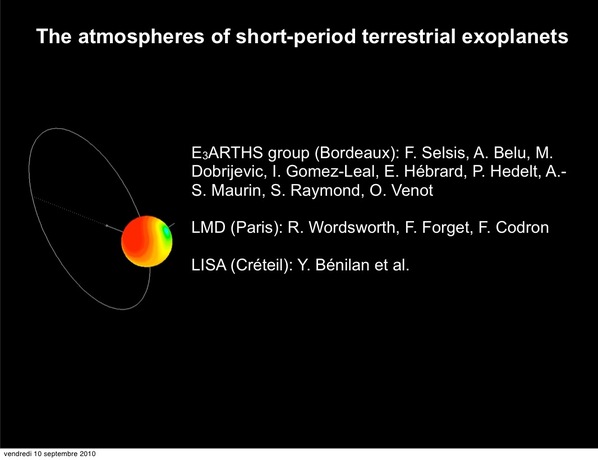Terrestrial Exoplanets > Franck Selsis

If initial loading stalls, switch to the Flash version.
Atmospheres of short-period terrestrial exoplanet
Franck Selsis
LAB, Bordeaux, France
Help



Abstract: Exoplanet searches have revealed an abundant population of low-mass planets (below 15 MEarth) with very diverse properties in terms of their orbits, the characteristics of their parent stars, and the planetary system in which they are found. Until we develop instruments (nuller, coronograph, occulter...) able to achieve the direct detection of terrestrial exoplanets, the physical/chemical properties of these planets and their atmospheres will have to be inferred from combined light observation (i.e. from a mixture of the light from the star and the planet). Such characterization will be restricted to particular planet types. For instance, infrared observations will have to target planets with a large-enough radius (and therefore significantly more massive than Earth) and planets that exhibit a high enough contrast with their star, meaning hot planets. Only in the case of very-low mass stars can we hope to start probing the atmospheres of habitable worlds. Although less appealing than more earth-like objects, short-period super-earths do represent an important science case and some should be observable already with JWST. Their atmospheres constitute a link between the gaseous envelope of hot- Neptune/hot-Jupiters and the atmospheres of Earth-sized terrestrial planets. They are subjected to strong tidal forces that affect their orbital evolution, rotation, structure and climate. They are also subjected to intense XUV and particle irradiation threatening the survival of their atmospheres. Gathering even basic information about the occurrence and properties of Super-Earth atmospheres as a function of orbital distance, mass, and spectral type of their host stars will provide fundamental constraints to our understanding of the origin and evolution of planetary atmospheres.
Additional materials: PDF of slides
ExoClimes 2010, Exeter, Thursday 9th Sep 2010
Additional materials: PDF of slides
ExoClimes 2010, Exeter, Thursday 9th Sep 2010
